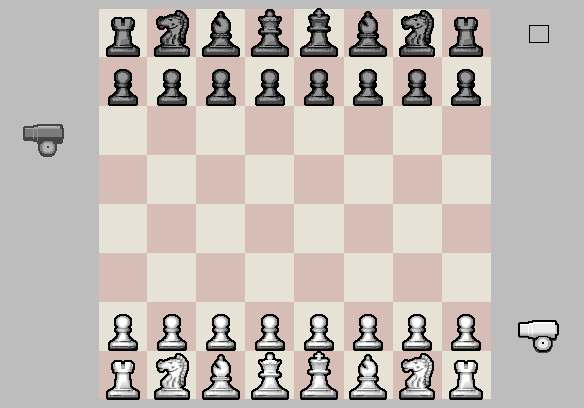

In Stoltz Chess the rules are the same as in orthodox chess, except that an extra piece per player are placed in the reserve. Before starting, the players must decide whether they want to use the extra pieces. To make a decision, press on the little black square. Only if both players choose not to use the extra pieces, then it becomes a regular game of chess. If white turns down the extra pieces, then black can overrule this.
If players have elected to include external pieces, they may either move a piece or pawn, or drop an extra piece from the reserve. Pieces may only be dropped on a friendly pawn on the second rank. The removed friendly pawn must immediately be relocated two squares ahead of the dropped piece. This position, and the position in between, must be empty. If not, the piece cannot be dropped on the friendly pawn. Should a player refrain from inserting his extra pieces at these occasions, then he has forfeited his chance of introducing them. Note that pieces and pawns are allowed to move before an extra piece has been dropped. You are allowed to make a pawn-relocation if in check, if the pawn-relocation covers the check. The relocated pawn can be captured by 'en passant'.
Stoltz Chess is normally only played with one extra piece each, namely the Culverin, which can step in any direction like a king. It can capture only by leaping over any piece, orthogonally or diagonally. If the nearest piece after the leap is an enemy piece, then it can be captured. Enemy pawns, however, can restrict its movement. The Culverin can only reach the square immediately behind the enemy pawn, regardless of leaping direction. Its value corresponds to a knight or a bishop (my estimate). A second piece can optionally be used. This is the Archbishop (Cardinal): combines the powers of a Bishop and a Knight. It is somewhat weaker than a Queen. The Culverin derives from Culverin Chess, which is very close, the only difference being that the pawn is relocated one step. The Archbishop was known already in the 17th century. D. Pietro Carrera used this piece in his variant Carrera's Chess. He wrote a long book on chess, called 'Il Gioco delgi Scacchi', and published it in 1617 in Miltello in Sicily.
In Stoltz Chess standard chess is included as an option, thereby maintaining the historical connection. In a tournament, by way of the initial voting procedure, players can decide to play a traditional game.
Introducing the external pieces implies a weakening of the pawn chain, so it's a difficult strategical question whether one should wait, or immediately make use of the drop move to advance a centre pawn two steps. But dropping an extra piece on the king- or queen pawn could block the development of the bishop. Waiting has its obvious advantages, although the alternative positions where the piece can be dropped will become fewer and fewer.
The Culverin can threaten an enemy rook on an half-open file. It is stronger than both its counterparts, the Korean cannon and Chinese cannon, making it easier to introduce it in a context of Western pieces. Note that the pawns constitute a good defence against the Culverin while it can only reach the square immediately behind the enemy pawn. By example, if the black king is checked on the g-file, it can defend itself by moving the pawn forward. While its tactical capacity is truncated the Culverin can harmonize with the positional qualities of the game. Positioned two or more steps behind a friendly pawn, it can threaten an enemy Culverin, which cannot threaten back. This is an important positional aspect. Stoltz Chess was invented and implemented by undersigned, May 2007.

Gösta Stoltz. Stoltz Chess was created in remembrance of Swedish grandmaster Gösta Stoltz (born 9 May 1904 - died 25 July 1963). Stoltz won individual gold medal at second board (+10 -1 =7) at the 4th Olympiad in Prague in 1931. He won team bronze medal playing at second board (+5 -3 =6) at the 5th Olympiad in Folkestone in 1933. Stoltz scored a spectacular victory in the Munich, 1941 tournament (München - 2nd Europa-Turnier), 1½ points ahead of Alekhine. Stoltz received the GM title, belatedly, in 1954. His playing style is reminiscent of Michail Tal and Alexander Aljechin, stable positional play interchanged with brilliant combinative sacrifices. The attached game is from the Interzonal tournament 1952 when Stoltz played brilliantly and sacrificed queen against the American Herman Steiner.
• You can download my free Stoltz Chess program here (updated 2009-10-21), but you must own the software Zillions of Games to be able to run it (I recommend the download version).
• Don't miss my other chess variants.
© M. Winther (May 2007).